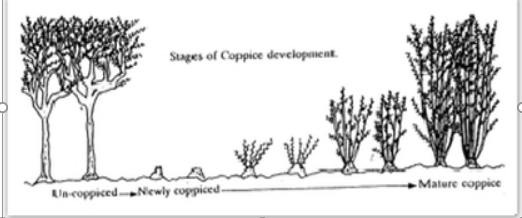
Coppicing as a Fuelwood Alternative
Details
Forests have different uses in different parts of China. While in the south many private landholders grow timber to sell it on the market, in all of China about 30% of its forest resources are still needed for fuelwood, especially the North is still largely dominated by a need for such. However, households with serious fuelwood shortage have reached 47.7 % of the rural population, leading to fuelwood not only being collected from designated fuelwood forests, but even protection forests that are in many places compromised in their ability to provide important ecosystem services, like water filtration in watersheds. Additionally, due to an increase protection forests the area of fuelwood forest has continuously declined since the early 1990s. While a switch to different energy sources might be one of the solutions in the long term, the fact is that in rural areas the dependence on a steady wood supply will not disappear in the near future.
Coppicing is an age-old forest management system and has been of special significance in many places in Europe. Coppicing uses the ability of selected tree species to resprout after being cut, effectively supplying small-diameter wood at a much shorter time interval than a normal forest wood do, even with regular thinnings. Moreover, different systems can provide different services, for example coppice with standards allows the owner to grow long-term timber, while also providing a steady fuelwood supply.
The advantages of coppicing can be summarized in 3 points:
1. simple in operation and suitable for small areas
2. short rotation (only a small amount of funds is tied up in the growing stock) and early returns are obtained
3. reduces fuelwood shortage
It is therefore recommended to try in areas with a need for fuelwood supply the coppice system. Depending on the specific region, there are a range of options of “classical” coppice species: hazelnut, chestnut or oak are great examples for potential coppice species, provided local varieties are suitable for coppicing. They can also be grown over longer periods of time (up to 20 years) to provide stronger wood. Another common species already present in many often degraded landscapes is the Chinese Chastetree (Vitex negundo). Studies have shown that Vitex has excellent regeneration abilities and can be harvested every 1-2 years, if kept in a coppicing system it slowly increases its biomass production over time. The short rotation period gives it a distinct advantage for short-term needs as usually forestry projects involved much longer timespans. The best results are produced if the harvesting time is selected that falls between the active growth period and the dormant stage in order to maximize the biomass production. This furthermore determines the cycle in which it can be harvested.
Sources:
Verma, S. C. and P. N. Misra (1989). "Biomass and energy production in coppice stands of Vitex negundo L. in high density plantations on marginal lands." Biomass 19(3): 189-194.
Tewari, S. K., et al. (2004). "Effect of age and season of harvesting on the growth, coppicing characteristics and biomass productivity of Leucaena leucocephala and Vitex negundo." Biomass and Bioenergy 26(3): 229-234.
Wang, X., et al. (2015). "Household Forests and Their Role in Rural Livelihood: A Case Study in Shangnan County, Northern China." Small-scale Forestry 14(3): 287-300.
Bartlett, D. (2016). "Traditional coppice in South East England: the importance of workforce engagement for development." iForest - Biogeosciences and Forestry 9(4): 577-582.
http://www.ecosystems-design.com/coppice-forestry.html
